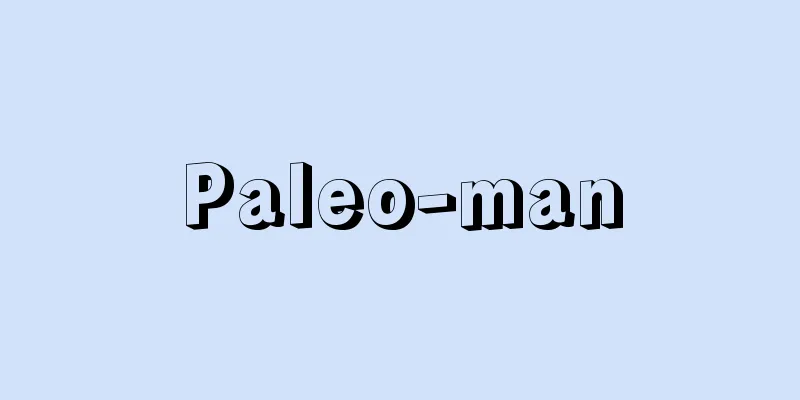Paleo-man

|
If human evolution is conveniently divided into four stages, humans in this third stage are Neanderthals and archaic sapiens. Humans before Archaic Man were ape-men and early man, and those after were modern humans. Archaic Man shows the following intermediate stage not only in terms of physical characteristics, but also in terms of era and culture. The brain volume is around 1450 cubic centimeters, which is the same as that of modern humans (Homo sapiens), and in some cases even larger. For this reason, it is even said that "as far as brain volume is concerned, humans have not evolved since Archaic humans." However, the braincase is low and the forehead is significantly inclined. In addition, the facial cranium is large, and is almost entirely used for the chewing organs. These are characteristics directly inherited from early man. The supraorbital ridge is developed in the area that corresponds to the eyebrows, and the external occipital ridge protrudes backward, sometimes forming a topknot-like elevation. Like the skull, the upper and lower jaws are also sturdy, and as a result, the canine fossa and chin seen in Homo sapiens are not seen. They are of a sturdy build. Archaic humans lived during the Third Interglacial Period and the First Subglacial Period of the Würm Glacial Period, approximately 150,000 to 35,000 years ago. Since their discovery in 1859 in Neanderthal, Germany, many remains have been excavated in Europe, but they have also been excavated in various parts of the Afro-Eurasian Old World, including Africa, the Middle East, China, and Java. A significant portion of the remains excavated in Europe lived in cold regions close to glacial regions. Many of these have unique exaggerated features, and are interpreted as being specialized. These are the so-called typical Neanderthals. At one time in Europe, archaic humans were reconstructed from these bones as having an ugly appearance, but today this has been corrected, and archaic humans are now considered to be the same species of Homo sapiens as modern humans. Archaic humans were responsible for the Middle Paleolithic culture. The representative of this is called the Mousterian culture. At first glance, Archaic humans are primitive, so their culture is often considered to be low, but they had a wide variety of stone tools and are thought to have used them in a very detailed manner. It has been revealed that the manufacturing method of these tools consisted of multiple steps and that they were processed in a planned manner depending on the quality of the stone, but there are no delicate artistic works like those of the next stage of humans, Cro-Magnon humans. Burial sites have also been discovered in various parts of Europe and Western Asia. Six human bones that seem to have been buried artificially were excavated from the La Ferrassie ruins in France, and all of the bones, including two adults who were probably parents and four children, were laid in an east-west orientation. At the Le Mouster ruins, several stone tools and animal bones that seem to be grave goods were placed next to the bodies. At the Shanidar ruins in Iraq, pollen from wild flowers that still bloom around the cave today was found in the soil under the human bones. It is likely that the dead were sent off with flowers. Thus, it is believed that archaic humans had a view of the afterlife, and furthermore, bones of a disabled person with one arm who lived to be about 40 years old were discovered at the Shanidar ruins, suggesting a spirit of helping the weak. Traces of a bear's skull and limb bones assembled together were found at Drachenloch in Switzerland, which are thought to be a worship service for the spirit of a bear. Bones with modern human characteristics have been excavated from older strata, such as Swanscombe in the UK and Fontechevalde in France, and these are called pre-sapiens or archaic sapiens, but they would probably rather belong to the archaic human stage. [Shise Kahara] [References] | | |Source: Shogakukan Encyclopedia Nipponica About Encyclopedia Nipponica Information | Legend |
|
人類進化を便宜的に4段階に分けた場合、その3番目の段階に位置する人類。ネアンデルタール人および古代型サピエンスがこれに相当する。旧人以前の人類が猿人と原人で、以後が新人である。身体的諸特徴ばかりでなく、時代や文化についても、旧人は次のような中間的段階を示す。 脳容積は1450立方センチメートル前後で現生人類(新人)と同程度、あるいはそれより大きめのものもある。このことから「脳容積に関する限り人類は旧人以後進化していない」とさえいわれる。しかし脳頭蓋(とうがい)は低く、前頭部の傾斜が著しい。また顔面頭蓋が大きく、ほとんどそしゃく器官となっている。これらは原人から直接受け継いでいる特徴である。眉(まゆ)に相当する部分に眼窩(がんか)上隆起が発達し、外後頭(こうとう)隆起が後方に突出して、ときには髷(まげ)のような高まりを形成する。頭骨と同様に上下顎骨(がくこつ)も頑丈で、そのため新人にみられる犬歯窩や頤(おとがい)はみられない。体格はがっしりしている。 旧人は第三間氷期およびビュルム氷期の第一亜氷期、年代的には約15万~3万5000年前に生存した。1859年ドイツのネアンデルタールで発見されて以来、数多くの遺骨がヨーロッパから出土したが、その後アフリカ、中近東、中国、ジャワなどアフロ・ユーラシアの旧世界の各地からも発掘されている。ヨーロッパ出土のものは、相当部分が、氷河地域に近い寒い地方に生存していた。これらには独特の誇張された特徴をもつものが多く、特殊化したものであろうと解釈されている。これが、いわゆる典型的ネアンデルタール人である。ヨーロッパでは一時期、これらの骨から旧人が醜い姿として復原されたが、今日では訂正され、さらに、旧人も新人と同種のホモ・サピエンスであるとみなされるに至った。 旧人は中期旧石器文化を担った。その代表的なものはムスティエ文化とよばれる。旧人が一見、原始的な形態であるため、その文化も低かったようにみなされがちであるが、石器の種類は豊富であり、道具のかなり細かい使い分けをしたと考えられる。その製作法も複数の工程からなり、石質に応じて計画的に加工されていることが明らかになっているが、次の段階の人類、クロマニョン人のような繊細な芸術的作品はみられない。また、ヨーロッパ、西アジアの各地から埋葬跡が発見されている。フランスのラ・フェラシー遺跡からは人為的に埋葬されたと思われる6体の人骨が発掘されたが、そのおそらくは父母であろう成人2体と子供4体のすべてが東西の方向に寝かされていた。ル・ムスティエ遺跡では、遺体の傍らに副葬品と思われるいくつかの石器と動物の骨が置かれていた。またイラクのシャニダール遺跡では、人骨の下の土壌から、今日でも洞穴周辺に咲く野の花の花粉が検出された。おそらく花を飾って死者を野辺送りしたものであろう。このように、旧人は他界観を有していたと思われるが、さらにシャニダール遺跡では40歳くらいまで生きた片腕の不自由な身体障害者の骨が発見されており、弱者扶助の精神があったことを思わせる。スイスのドラッヒェンロッホではクマの頭骨と四肢骨を組み合せた跡がみつかっているが、クマの霊を祭ったものと考えられる。 イギリスのスウォンズクームやフランスのフォンテシュバードなど、より古い地層からも新人的特徴をもつ骨が出土しており、これらはプレ・サピエンスまたは古代型サピエンスとよばれるが、むしろ旧人の段階に入るものだろう。 [香原志勢] [参照項目] | | |出典 小学館 日本大百科全書(ニッポニカ)日本大百科全書(ニッポニカ)について 情報 | 凡例 |
<<: Radical Socialist Party (French: Parti radical-socialiste)
>>: School lunch - school lunch
Recommend
Murasaki Shikibu
Dates of birth and death unknown. A female writer...
Crushed peasant - crushed peasant
In the Edo period, this term refers to peasants wh...
Ekkehart IV
...In addition, Roswitha also produced works such...
Shibukawa clan
Kyushu Tandai during the Muromachi period. A desc...
Seven Sages
The seven philosophers and politicians who were re...
Moritake Senku - Moritake Senku
A collection of haikai linked verse by Moritake. ...
Karuya - Karuya
...The term "sacred Balad" refers to Me...
North England Highlands
…The area is covered with a wide range of barren ...
Mergus albellus (English spelling)
… [Yanagisawa Norio]. … *Some of the terminology ...
The Hagi Rebellion
In 1876 (Meiji 9), disgruntled samurai led by Mae...
Blast furnace cement
...used for large blocks of concrete such as dams...
Kayanuma Coal Mine
...Japanese people began to live here in the latt...
Related Tree Law - Kanrenjumokuho
...It is also a method to analyze whether the goa...
Kantan (Oecanthus longicauda)
Known as the queen of chirping insects, this insec...
Natal
The capital of Rio Grande do Norte state in northe...









